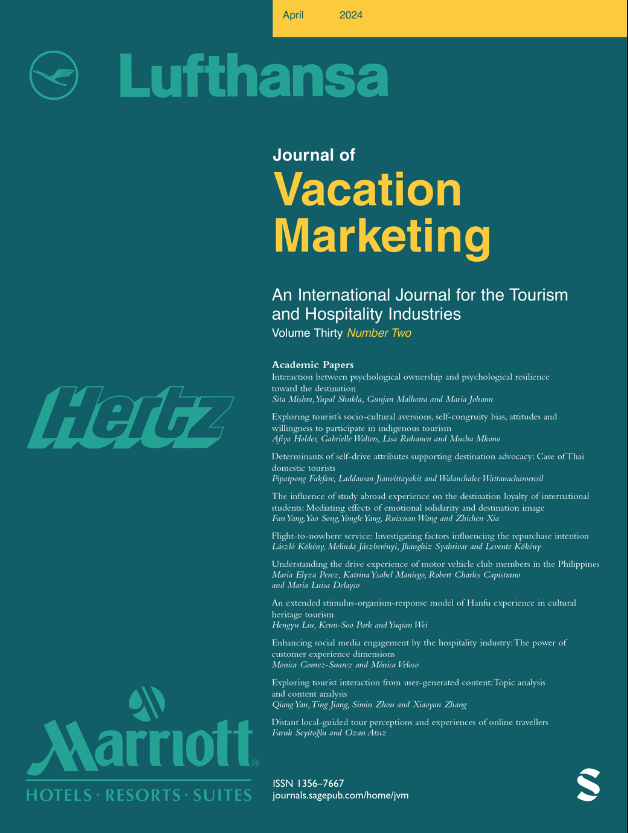旅游目的地图像研究的知识结构(2001-2023):背景、大流行前概述、COVID-19期间的变化及其对未来的影响
IF 4.5
3区 管理学
Q1 BUSINESS
引用次数: 0
摘要
我们的目标是绘制两个纵向时期的目的地图像(DI)研究的智力结构及其理论发展:第一,从2001年到新冠病毒爆发和疫苗批准之前(2001 - 2020);第二,在2019冠状病毒病期间(2021-2023年)。这是第一篇使用共被引分析的文章,该分析仅关注于DI,确定了该领域的主要集群、智力转折点和引文爆发论文。在Covid-19之前和期间研究文献计量学可以帮助了解大流行对研究产出的影响以及研究重点的转变。这种方法通过从评估和关系的角度认识到直接投资的内在本质,扩展了旅游科学。共引指的是被引用的内容,而不是被引用的论文。第一阶段的研究结果显示:1)目的地管理组织(DMO)关于品牌相关的直接投资的理论背景;2) DI的组成部分及其与访客行为的关系;3)互联网和用户生成内容(UGC)如何成为感知DI的主要来源。鉴于,在第二个时期,已经确定了两个主要变化:1)大流行对旅游业的影响和感知的旅行风险;2)一种新方法的出现,重点关注人们通过生活体验与目的地的接触。这些结论可以帮助供应商、旅游组织和政策制定者在大流行之前和期间了解旅游直接投资的组成部分,并为旅游业适应新常态提供有价值的见解。本文章由计算机程序翻译,如有差异,请以英文原文为准。
The intellectual structure of destination image research in tourism (2001–2023): Background, pre-pandemic overview, shifts during COVID-19 and implications for the future
We aim to map the intellectual structure of destination image (DI) research and its theoretical development in two longitudinal periods: firstly, from 2001 and before the outbreak of Covid-19 and approval of vaccines (2001–2020); and secondly, during Covid-19 (2021–2023). This is the first article to use co-citation analysis that focuses solely on DI, identifying the main clusters, intellectual turning points, and citation burst papers in this field. Studying bibliometrics pre- and during Covid-19 can help to understand the impact of the pandemic on research output and the shift in research focus. This methodology expands tourism science by recognising the intrinsic nature of DI from an evaluative and relational point of view. Co-citation refers to the cited not the citing papers. The results in the first period show: 1) theoretical background on DI associated with branding from Destination Management Organisations (DMO); 2) the components of DI and their relationship with visitor behaviour; 3) how the Internet and User-Generated Content (UGC) have become the main sources to perceive DI. Whereas, in the second period, two main shifts have been identified: 1) the impact of the pandemic on tourism and perceived travel risk; 2) the emergence of a new approach focusing on the engagement of people with the destination through life experiences. The conclusions could help suppliers, DMOs, and policymakers to understand the components of DI before and during the pandemic, as well as provide valuable insights for the tourism industry to adapt to the new normal.
求助全文
通过发布文献求助,成功后即可免费获取论文全文。
去求助
来源期刊

Journal of Vacation Marketing
Multiple-
CiteScore
9.70
自引率
15.70%
发文量
54
期刊介绍:
Journal of Vacation Marketing is a fully peer reviewed international journal that publishes original research and review articles on topics relating to the marketing of destinations and businesses/organisations involved in the wider tourism, hospitality and events industries. Its objective is to provide a forum for the publication of refereed academic papers and reviewed practitioner papers which are of direct relevance to industry, while meeting the highest standards of intellectual rigour.
 求助内容:
求助内容: 应助结果提醒方式:
应助结果提醒方式:


